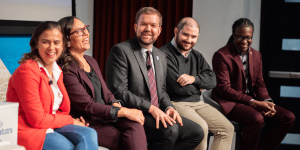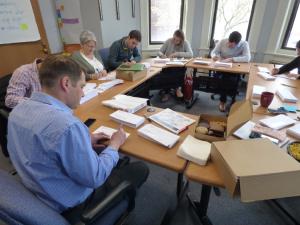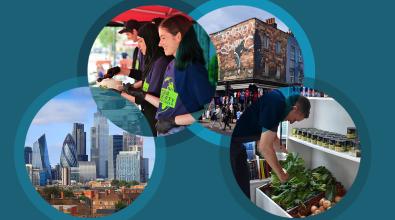How to make innovation capacity stick for the long haul

One of the most recent and important developments in local government these days is for cities to hire “chief innovation officers,” and often, teams of people to work with them. These innovators are leading the charge on finding new ways to solve local problems, marshaling tools like data analysis, human-centered design, and behavioral research to help their partners both in and out of City Hall produce better outcomes for residents.
As momentum grows for these investments in innovation capacity, a key question is: How can cities make it stick? While there’s little doubt local governments need this core capability, it remains a challenge for city leaders to fund and maintain support for innovation teams — especially when so much of the work leads them into complex issues where meaningful gains can take time and entrenched opposition or bureaucratic inertia can be part of the problem.
As head of the innovation teams (i-teams) program at Bloomberg Philanthropies, I have a front-row view into how these dynamics play out on the ground. As the grants for our second cohort of 13 i-teams wind down, I’ve been reflecting on lessons these cities have learned. Here are five takeaways on how to build innovation capacity that lasts.
1. Pick issues to work on carefully
It’s important that i-teams dive into top-priority issues that represent serious challenges in the city. That’s why Bloomberg Philanthropies-supported i-teams work on issues that measurably affect residents and are chosen by the mayor: It increases the chances that the work will receive sustained attention from city leaders and other stakeholders whose support matters, and more importantly, it will create impact on the things that matter most to the people who live and work there.
We saw this clearly in Boston, where the i-team chose to work on affordable housing. It not only was a pressing issue in a growing city with soaring rents, but also a signature part of Mayor Martin J. Walsh’s campaign platform. The Boston team created a “Housing Innovation Lab” to engage residents and housing experts in understanding the problem and come up with innovative ideas, such as an “intergenerational homeshare” program that matches older homeowners with rooms to rent with people who need a place to live. Walsh saw so much value in the approach that he turned the lab into a permanent City Hall office.
Even as they take on big gnarly issues, it’s critical for i-teams to “right-size” those problems to a scale where they can make meaningful impact as quickly as possible.
Tel Aviv is a great example. With their city ranked among the world’s 10 most expensive places, Tel Aviv’s i-team chose to tackle the city’s high cost of living. Of course, that’s too big a problem for five city employees to solve on their own. But by zeroing in on one population deeply impacted by rising costs — families with children — they found many paths to impact, such as adding new space for childcare facilities and starting a school lunch program for high schoolers that was unprecedented in the city. Altogether, the initiatives have the potential to save a family as much as $1,400 a year per child if they take advantage of them.
2. Build City Hall support from the top-down and bottom-up
If they’re to be successful, i-teams need a clear mandate from the mayor and other top city leaders. That’s, in part, because their work tends to cut across government agencies: Having the mayor’s continuous backing keeps doors open. Equally important is developing clear ownership of the innovation work and sponsors who can advocate for the team and accelerate progress. Both have been key to work in Los Angeles, where the i-team enjoys public support from Mayor Eric Garcetti and the ability to work across multiple departments which comes from being located in the Mayor’s Office of Budget and Innovation.
At the same time, it’s critical for innovation staff to build deep relationships with the agencies and front-line staff they work with, as well as nonprofits, universities, and other community partners. That not only builds a broad base of support for the work, but also lays a foundation for lasting change in the way City Hall solves problems.
One team that has done this well is in Syracuse, N.Y. They’ve trained almost 70 city employees in innovation techniques, arranged ideation lunches for employees to tackle specific challenges, and held competitions for new ideas from city staff. These interactions have broadened and deepened the culture of innovation across the organization, resulting in many more solutions than the i-team alone could develop while building rapport between the i-team and front-line staff. The Syracuse team also developed strong ties with a number of department heads, as well as Syracuse University, Code for America, and United Way. Building such a support network made it easy for a new mayor, Ben Walsh, to not only continue but accelerate innovation work that had begun under his predecessor.
3. Build a team with diverse skill sets and strengths
It takes people from different backgrounds, with different perspectives, to make innovation blossom. Look at the i-team in Los Angeles: The director, Amanda Daflos, comes with experience as a private-sector consultant; her deputy is a government veteran; a data scientist brings depth and accuracy to their quantitative work; and multiple designers drive a rigorous human-centered approach to innovation. Members of the team also have journalism, IT, and engineering in their backgrounds, and the majority of the staff today are women.
“The range of skills has allowed us to deliver everything from new programs to IT products to behavioral science projects to marketing to very large skills-based learning conferences,” Daflos said. “The mix of skills, and the strong management and cultivation of those skills, is essential to the success and the cachet of the team.”
A few skill sets are proving particularly important for i-teams, in part because they’re pretty new to local government. The first is data skills. Having a data analyst on hand is critical for researching and understanding a new issue area. It’s also essential to identifying a baseline about the size of the problem at the start of a project and analyzing whether interventions are working once they are implemented. Syracuse’s i-team took a data-driven approach to fixing aging infrastructure. The effort not only cut the number of water-main breaks by 42 percent, but also saved more than $1.2 million on road work and inspired City Hall to hire the i-team’s data guru, Sam Edelstein, as the city’s first Chief Data Officer.
Another skill set is human-centered design. Designers approach public-sector problem solving by first trying to understand what is really going on for residents, and then working backward to develop a mix of practical and creative solutions. They’re curious by nature and are trained to challenge assumptions to find what has been overlooked or misconstrued, identify the root causes of problems, and prototype and test solutions with residents to be sure new programs address real needs before a city invests in them. Almost all of the Bloomberg i-teams now have at least one designer on staff, and several have two.
[Read: Meet the new force shaking up city halls: designers]
Another key skill set is knowing how to apply insights from behavioral science to improve outcomes. That’s what the L.A. i-team did to help the police department’s effort to increase the number of officer recruits. After finding that more than one-third of applicants drop off when asked to submit a personal history statement, the i-team redesigned the form and began sending emails and text messages to applicants to remind them to complete it. The intervention increased the number of people moving through the hiring pipeline, and boosted enthusiasm in the city for using behavioral “nudges.”
4. Tell the story of the work
Storytelling is often the last thing on the mind of an i-team deep in research with residents or preparing to launch a complex initiative. But it’s critical to build a public narrative around the team’s work. Internally, it helps cement the i-team’s reputation inside City Hall as a key player generating results. And externally, it helps the public see why innovation in local government matters.
One reason storytelling is so important is because an i-team’s work can sometimes be seen as wonky or inaccessible. So it’s imperative to use everyday language to describe what the team is up to, and to show the impact on the lives of people living and working in the city. The Seattle i-team does this by regularly surfacing and sharing pictures and quotes from impacted residents on its on its blog, while teams in L.A. and Long Beach, Calif., share regular newsletters to highlight key accomplishments.
Storytelling is also about engaging and updating senior leaders and colleagues in City Hall. That means taking key stakeholders out into the field when i-teams are doing ethnographic research, so they can experience the power of this approach in understanding the root causes of problems. It also means inviting people into the team’s working space, which in many cities are open areas built for collaboration. There’s no better way to show curious colleagues the i-teams way of problem solving than to give a tour, and answer questions about, sticky-note boards full of research insights and ideas for solutions.
[Read: How rethinking your office space can spur innovation]
When the Jerusalem i-team got started, many stakeholders inside and outside of local government had trouble understanding what the team did. The team brought on a communication specialist to craft clear narratives about their impact and boost media coverage of it. As a result, more stakeholders began to understand what the team was doing and why it mattered. For example, with projects like “Coming Soon,” the i-team aimed to boost local businesses by surveying residents about what services they want to see in their neighborhoods — supplying local entrepreneurs with valuable market research. Increased awareness of this and other work helped the team win permanent funding.
Without a megaphone, it can be difficult for i-teams to raise awareness or support for their work, even when they produce strong results.
5. Plan for sustainability early on
Investments in innovation pay off in the end. They save money, increase efficiency, and produce better outcomes. Still, there are costs to cover, most notably staff salaries. Whether underwritten by grant money or not, every i-team must plan early and continuously around the question of how to sustain funding.
Long Beach is a good example. The team there started up its i-team with funding from Bloomberg Philanthropies in 2015. It wasn’t long before the team began discussions with city leadership about different ways to continue the work. By the time the grant ran out last year, the team’s director, Tracy Colunga, had worked out a new funding model. Agencies now hire her team to bring their data- and design-driven methods to bear on specific projects, paying from their own budgets.
[Read: Chief innovators come of age]
That’s just one model for sustainability. Some i-teams have continued operating by tapping into local philanthropic sources. Meanwhile, many others have launched as or converted into fully city-funded enterprises. For them, the key is to get quick wins early on in order to secure a longer runway to work on bigger projects that may take more time to show impact.
Committing to the best practices mentioned above will help an i-team build a solid foundation for sustainability. But it is not enough. Teams also need to be good partners with the departments they collaborate with, and make sure those departments get the spotlight when things go well. Teams also need to be relentless about measuring their impact and continually report those numbers to senior leaders and the public.
Of the 13 Bloomberg i-teams whose grants have most recently wound down, all have maintained at least one staff member, and almost all of them have either retained their full staff or expanded them. Meanwhile, in the U.S. alone, more than 70 cities now have a chief innovation officer, a number that keeps on growing. These are strong signs that city leaders see the value in these investments and maintaining innovation capacity for the long haul.





